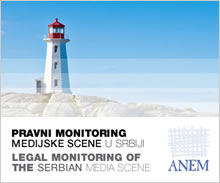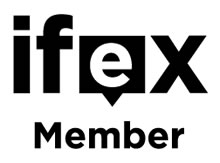07. 03. 2012
Editors, officials, media reps discuss media strategy
Belgrade, March 7, 2012. (CorD, B92) - Journalists, editors, representatives of media organizations and officials look at Serbia's Media Strategy in a series of articles orginally published in the CorD magazine
Saša Mirković, President of ANEM:
Last year's adoption of the Media Strategy (which is one of the political preconditions for Serbia's accession to the EU) could be, characterized, undoubtedly, as a success for at least two reasons: we have been waiting for this framework agreement for eleven years and its adoption united all the relevant media associations and affiliations.
Up until then, media associations, which were very much polarized and disunited, came together on principle by distancing themselves from certain solutions imposed by the government in the strategy, with the main ones forming regional radio and TV public services and the national councils being given the right to found their own media in national minority languages.
Ever since the media strategy was adopted, it was clear that time would not be an ally in the implementation of the solutions stated in the action plan. Now, it is clear that there will be a delay in enacting certain legal regulations as a prerequisite for practical implementation of the measures stated in this government document.
On top of this problem, there is also the matter of the elections which will preoccupy our political elite and block the functioning of the State Parliament which, in turn, will result in the media matters being pushed aside despite their urgency.
It is encouraging to hear that task forces for drafting relevant regulation, as envisaged by the action plan, are currently being formed.
It is, however, disconcerting to see, from the decisions made regarding the allocation of budget funds, that the government has shown a tendency not to behave in accordance with the proclaimed principles from the media strategy and that it has been openly favouring certain media which, so far, have been treated in a way that is contrary to a fair market.
Following the adoption of the media strategy, the changes made to the Law on Cinematography and the new SOKOJ tariffs left ‘a bad taste in the mouth', as did imposing an additional burden on local broadcasters, which has further reduced the manoeuvring space for the expected reduction in taxes.
If such trends continue, it will become increasingly clear that the media strategy will become a dead letter.
In that case, it will be necessary for the media coalition, with the help of the European Commission and OSCE, to continue putting pressure on the government to stick to what had been agreed hoping that the negotiations with the European Union will start as soon as possible so that we can begin implementing thorough reform of the current media system which is, in its most part, obsolete and old.
Adoption is success
Dragana Milićević-Milutinović, State Secretary, Ministry of Culture, Information and Information Society:
The Media Strategy was adopted in June last year. Although the Strategy's text was written by journalist associations and affiliations, it seems that most of them would be happier if the Strategy had never been adopted, with the exception of a few shining examples. Certain creators of the Strategy, which was drafted for the Ministry of Culture, Information and Information Society, were engaged solely to satisfy personal interests. Even at the very end of writing the strategy everything that had been done up to that point was questioned since very specific personal interests were much stronger than general ones. I have kept quiet all this time, although there is so much I would like to say, so, in that respect and aware of the opinions that certain people also covering this topic are going to express, I am willing to be a participant in a story or an article, which I expect to have a multitude of inaccuracies.
Truth has always been easy to check and prove, and the truth is the following:
The following has been done in the past period in line with the action plan that is an integral part of the Media Strategy:
- The work on drafting the Law on Broadcasting is finished;
- A task force, in charge of writing a new Public Information Law, has been formed and is operational. The task force is made of influential members and the deadline for drafting the law is 30th March, 2012;
- Formation of a task force that will draft the Law on Public Service Broadcasters is pending. Two more members of this group will be appointed next week and the deadline for writing this particular draft law is 15th March, 2012;
- Also, formation of a task force in charge of drafting the Law on TANJUG News Agency is ongoing. The deadline for writing the Draft Law is also 15th March, 2012;
- We have sent a written initiative to the Ministry of Education, asking them to consider the possibility of introducing so-called media literacy to the country's educational system, which is one of the tasks stipulated in the Strategy. The Ministry did include our initiative in the Draft Law that has already been forwarded to parliament for adoption;
- We have also sent a proposal to the Ministry of Finance to consider reducing the VAT rate for those legal entities that are founders of public media;
- We have forwarded to the Ministry of Finance a proposal for a more precise definition of the rules regarding the allocation of state financial assistance to public media;
- In that respect, we have started concluding agreements with public media which have been founded by the Republic of Serbia and which provide information of public interest;
- We have written a new set of rules about conditions for funding public information projects, as well as established a pattern that is used to justify spending of the allocated money.
In conclusion, I would like to add that representatives of the European Commission and OSCE have participated in the work done by the above mentioned task forces.
Secondly, the Media Strategy is the basis for regulating the entire public information segment. The Strategy sets certain deadlines and the Information Sector is entirely dedicated to the implementation of the action plan, which can be seen from everything I have previously mentioned.
I consider the adoption of the Strategy, that has been in the making for years, a success, both for me personally and the entire Information Secretariat. The Strategy was adopted in matter of a few months since my appointment to the position of state secretary.
I also think that the Strategy's text is of high quality and will serve as a good foundation. Even Mr. Vincent Degert said that our work and the Strategy's text were of exceptional quality.
There were too many lies said about the adoption of the Strategy, so I am not going to dwell on them since readers will be able to discern for themselves who has good intentions and who hasn't. The facts that I have just mentioned, which speak about the serious and hard work we have done in implementing the Media Strategy, are going to point out who actually wants to see the public information sector properly regulated, and who is guided purely by personal interests, profit or his or hers party's interests.
If we simply compare the aforementioned activities of the information secretariat to what certain individuals have been saying, the readers themselves will be able to find an answer to the question in whose interest is it to have a regulated public information sector harmonized with European standards and who has other interests.
Strategy "Holy Scripture" for future laws
Veselin Simonović, Editor-in-Chief of Blic daily:
In itself, the Media Strategy cannot improve the conditions in which the media sector operates today since the Strategy is just a framework document which contents should be included in the future laws within a set deadline.
The direction which we should take in solving the current issues are, for the most part, well defined in the Media Strategy, but that doesn't automatically mean that the laws, which will be written in the following period, are going to be of good quality. Task forces in charge of writing the relevant law should treat the document as it were ‘the Holy Scripture'. I would like to recommend to the line ministry to keep the task force together that wrote and coordinated the Media Strategy's text, and to check the validity of the proposed legal solutions with the task force. The quality of future laws will largely depend on the members of the task force. I don't want to be judgmental and critical in advance, but I do have a need to recommend that the members of these groups should not be perennial media ‘experts' or, if that is a given, their number in a task force should be reduced to a minimum.
The Media Strategy is a good document because the abovementioned experts haven't had a chance to spoil it. If my information is correct, some task forces have already been formed and some are about to be formed, but none of their proposals are going to be subjected to a public debate until the autumn. The reason for this is simple - the election campaign is ongoing and the question remains whether the new ministers and new government are going to form their ‘own' task forces.
Because of the impending election, it is absolutely unimaginable for the current government to give up control over the media which it either owns or co-owns and I am pretty sure that the next government will not consider that a priority. The same goes for other key parts of the Media Strategy.
Hence, I think the key thing for the media sector in Serbia, following the changes in power, is to insist that the Media Strategy remain the so-called ‘umbrella document' for the relevant laws, since the Strategy was written by experts, journalist and media associations and affiliations.
Only together can we defend something that we have struggled to attune and adopt.
Strategy not enough
Branka Đukić, Director, Tanjug News Agency:
At this moment, 11% of the global adult population has a tablet computer and over 50% use them to read the news every single day (source: Economist Group). The revenue from advertising in the social media was $54 billion (€40.9bn) in 2011 (source: E-Marketer) and, by 2013, this revenue will double.
So, what are we talking about here? We are talking about having to catch up with the media reality in the rest of the world. The problems associated with copyright, multi-media approach, monitoring piracy, responding to new market demands and, especially, technological challenges are the issues that global media are dealing with. The Media Strategy regulates topics that we should have dealt with a long time ago. The Strategy is late (which doesn't bring into question the necessity of having such a document), but it is worrying to see that the Strategy adopted at the time of a global financial crisis, media crisis, parliamentary elections, and Serbia's EU bid which alters the perception of things, shortens deadlines and narrows down the manoeuvring space for implementing solutions stated in the Strategy.
It is very difficult to say what has been done in the implementation of the Media Strategy so far.
I assume that somebody is taking care of it. The fact remains that there were two issues that were dominant in the public - regional public service broadcasters and the status of the Tanjug news agency. Everything else, it seems, wasn't appealing enough to the participants of the public debate. It is also a fact that those two issues, particularly the issue of transforming Tanjug, were opened up by very specific interest groups.
So, for instance, the transformation of Tanjug (which "should be done in any way in accordance with the law," to quote the Strategy) is understood to be the privatization of Tanjug. The Croatian news agency HINA has been transformed into a public institution. Privatization is a valid transformation format. However, I am convinced that when people say "privatization" they actually mean privatization done the local way -buy cheap, ruin it and you build a totally different business on the ruined company's premises.
But that is not privatization.... That is a 1990s phenomenon.
Tanjug's transformation is pending, from the inside. In this case, the owner - i.e. the state - will have the final say. If the state discerns that it is in the public interest to have one public service broadcaster and that everything else should be relinquished to private ones, which are often funded by foreign and frequently mob-related capital, then we are going to say OK. Our contribution to the whole matter will be that, in the meantime, we have raised the value of the agency by advancing the quality of its services, turning it into a market orientated company and paying off the huge debt that we inherited.
Will the Strategy improve the working conditions in the Serbian media outlets? Yes, it will. The question is whether that will be enough and whether the improvement will be deep rooted. If it all boils down to transforming Tanjug, than we have just wasted our time. Yet again. At the last conference of the European news agencies, the participants talked about the many problems that media had to deal with, the most difficult problem being labelling news as ‘free of charge'. However, the biggest challenge for today's media is in finding new formats, overcoming the crisis with traditional clients and adjusting to mobile and social networks.
Does the Strategy have answers to these questions? I doubt it.
State preventing equality
Vukašin Obradović - President of NUNS:
The value of the Media Strategy, as a framework document, is going to be primarily reflected in the implementation of an action plan that stipulates the creation of a different legislative environment in Serbia, i.e. an environment where the state would withdraw its ownership share in the media and have its role reduced to funding matters of public interest where we would clearly know who are the real owners of the media and whether an unlawful media concentration has taken place. The Media Strategy is supposed to ensure equality amongst all media subjects in the market primarily through public competitions and the work done by independent commissions.
On the other hand, I hope that the state authorities are going to abandon the concept of regional public service media since that concept, in the opinion of the media coalition, is practically unrealizable and, realistically speaking, harmful to the interests of the media sector and citizens. I believe that the state will revise its stance on the national minority media and I see no reason why national councils should be allowed something that no other institutions are allowed to do.
Concerning what has been done so far in the implementation of the Media Strategy, the answer to that question is almost nothing. The Action Plan stipulates enacting a new Law on Public Information Service, drafting a law that would regulate the work done by the ‘electronic media', as well as the law on Public Radio and TV Broadcasting Services. All of that was supposed to have been done in 18 months. As you probably know, the work on these laws hasn't even started, which was expected to a certain degree since it is unrealistic to expect that the government will deal with very sensitive legislative matters during this pre-election period. What does concern us is the state avoiding the implementation of the Law on State Assistance, which is an obligation that stems from the Media Strategy, and which came into force on the 1st January 2012. This law bans the state from providing assistance to those subjects that, through that assistance, could gain a privileged market position. The state authorities have already allocated money for funding the Tanjug news agency, to the disadvantage of the other two news agencies - Beta and FoNet.
Also, nothing has changed in financing local and regional media. Municipal and town budgets still stipulate old-fashioned voluntary financing so if the money is allocated only to non-privatized media, which are founded by local self-governments, other media will simply die out. At the risk of sounding cynical, we could say that the existing financing format for the local media will result in only state-run and religious media surviving since they are the only ones with stable financial resources.
Ineffectual strategy
Zoran Sekulić, Editor-in-Chief of FoNet news agency:
It's been five months since the Serbian Government adopted the Media Strategy at one of its telephone sessions. The Strategy is an ‘umbrella document' that will be used in a thorough legal reform of the media sector. In the meantime, having this document had no effect on the situation in the media or on journalism. At least not a positive one.
The deadlines for implementation of the Strategy, as stated in the Action Plan, are too long. It is futile to expect the state authorities to be seriously engaged in the legal transformation of the media scene before the elections or even start creating an environment for implementing the key segment of the Strategy - the state withdrawing as a media owner.
However, what was expected and imperative was changing the way in which state-owned media were funded. The Action Plan stipulates the implementation of the Stabilization and Association Agreement, i.e. pertaining to control of state financial aid and protection of competition, as of 1st January 2012. The Law on State Aid stipulates an inappropriately high threshold of illegitimate state aid (to the tune of 30 million euros), while details of the government's act about the law's application are not revealed.
The fact remains that four state-funded media outlets (Tanjug, Radio Yugoslavia, Yugoslav Review and Panorama) will receive budget money this year too in the amounts similar to last year. This means that the state, via Tanjug, is still going to be a participant in not only the media scene, but also the media market, thus prolonging an already unsustainable situation of unfair competition compared to private news agencies.
Bearing in mind that, judging by most estimates, 2012 will be the most difficult year of transition and that, due to the two election rounds, the year will be pretty much focused on continuous election campaigns, it seems that not much should be expected from the Strategy this year.
Unofficial sources say that the Ministry of Culture's taskforce has already prepared the draft Law on Broadcasting, in addition to a taskforce for writing the draft Information Law that has been put together. These sources also claim that the formation of taskforces, which will write the draft laws on public information services and Tanjug, are also pending. Allegedly, the ministry intends to finish writing the four aforementioned draft laws before the election.
Even if that happens, although I think that the plan is overly ambitious, the future government, which is probably not going to be formed until late summer or September, is not obligated to endorse what its predecessors did and could start the whole procedure all over again. We should be under no illusion that political and other power centres will voluntarily give up their direct influence, control, pressure and blackmailing of media in the near future.
Hence, it is uncertain whether, in spring of next year, the first set of new media regulations will be adopted, as stipulated in the Action Plan and whether the process of necessary dispossession of the state in the media sphere will begin. It is also uncertain how many media will be around to see that.
If, in the meantime, the decision on Serbia's EU candidacy bid is again postponed for a longer period, the painstakingly adopted Strategy will be just a dead letter. At the time of a devastating economic crisis and a shortage of money, another scenario is also possible - the operation was successful but the patient died. A third outcome, that would be beneficial for both media and society, is, unfortunately, not even being contemplated for now.
Unconvincing plan
Nino Brajović - Secretary General of the Association of Journalists:
If we are talking about the Media Strategy (i.e. the Strategy for Development of the Public Information Service in the Republic of Serbia until 2016), we have to underline that this is a document whose adoption was one of the prerequisites for Serbia obtaining EU candidate status. So, this is not a document that was originally envisaged to exercise the government's will to improve media regulations. The Strategy is a forced move made by the governing elite on the country's euro-integrations path because the confined and unregulated media segment and preposterous judiciary reform represented serious hurdles in Serbia's aspirations toward EU membership.
Validation of this claim, i.e. the claim that the government launched the Media Strategy as a way to collect valuable points in the European agenda, can be seen in the final version of the document in which the Serbian Government, despite serious opposition from the Media Coalition (made of important professional and media associations like UNS, NUNS, NDNV, ANEM, LOKAL PRESS and the Media Association) kept public regional TV stations as an integral part of the state's information system. Although the Media Strategy covers public regional broadcasters, the Strategy itself does not regulate their funding which is conducive to the idea of the state continuing to exert influence in the founding and funding of these media organizations. At the same time and despite antagonism coming from the media community, the Strategy says that the national minorities' councils can establish their own media that will have editorial independence.
If we are talking about what is happening in practice, we should mention that the editor-in-chief of the Magyar Szo daily Csaba Pressburger was replaced last summer since this newspaper did not report enough on the activities of the Speaker of the Vojvodina Parliament, Sandor Egeresi, and failed to cover all press conferences held by the Alliance of Vojvodina Hungarians. Soon after, the editor-in-chief of the Panon TV, Rudolf Mihok, was also relieved of his duties since the medium he managed did not provide continuous coverage of the celebration of the national Hungarian holiday.
In light of the abovementioned facts and in response to your question ‘How much is the Strategy going to improve the working conditions in the Serbian media space?' I have to express some reservations. My answer is also prompted by the first serious test that the Strategy is going to be put through, i.e. the implementation of the Law on State Aid Supervision that came into force on 1st January 2012. The Law stipulates limits on how much financial aid the state can give to legal entities and natural persons that could result in obtaining a better market position. If we are talking about media, and especially public media enterprises, the said limitations still don't apply to them.
-
No comments on this topic.





